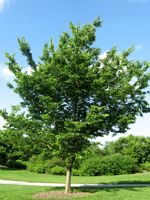Mon-Fri 9am - 5pm Mountain time
Common Hackberry vs Russian Mountain Ash
Celtis occidentalis
Sorbus aucuparia Rossica
NOT AVAILABLE THIS SEASON - MIGHT RETURN
The Common Hackberry is a medium-sized deciduous tree that resembles the American Elm but is immune to Dutch Elm Disease. They are versatile and can adapt to a variety of growing conditions.
It produces purple-red, berry-like fruit with a large seed in the center. Both the sweet flesh, which tastes similar to dates, and the crunchy seed are edible. The fruit remains on the tree throughout the winter, offering a valuable food source for birds and other wildlife.
The Common Hackberry can also be a great addition to a pollinator garden. The tree itself is a host for the larvae of several butterfly species and the flowers provide a source of pollen and nectar.
The Russian Mountain Ash is a stunning ornamental tree with the perfect pop of colour. It bears white flowers in the spring and gorgeous orange berries in the fall. Birds enjoy the berries that persist into the winter. It grows tall and can thrive in an urban setting making this an attractive ornamental tree for your landscaping project.

